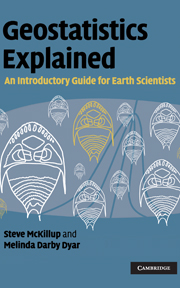Book contents
- Frontmatter
- Contents
- Preface
- 1 Introduction
- 2 “Doing science”: hypotheses, experiments and disproof
- 3 Collecting and displaying data
- 4 Introductory concepts of experimental design
- 5 Doing science responsibly and ethically
- 6 Probability helps you make a decision about your results
- 7 Working from samples: data, populations and statistics
- 8 Normal distributions: tests for comparing the means of one and two samples
- 9 Type 1 and Type 2 error, power and sample size
- 10 Single-factor analysis of variance
- 11 Multiple comparisons after ANOVA
- 12 Two-factor analysis of variance
- 13 Important assumptions of analysis of variance, transformations and a test for equality of variances
- 14 Two-factor analysis of variance without replication, and nested analysis of variance
- 15 Relationships between variables: linear correlation and linear regression
- 16 Linear regression
- 17 Non-parametric statistics
- 18 Non-parametric tests for nominal scale data
- 19 Non-parametric tests for ratio, interval or ordinal scale data
- 20 Introductory concepts of multivariate analysis
- 21 Introductory concepts of sequence analysis
- 22 Introductory concepts of spatial analysis
- 23 Choosing a test
- Appendices
- References
- Index
3 - Collecting and displaying data
Published online by Cambridge University Press: 05 June 2012
- Frontmatter
- Contents
- Preface
- 1 Introduction
- 2 “Doing science”: hypotheses, experiments and disproof
- 3 Collecting and displaying data
- 4 Introductory concepts of experimental design
- 5 Doing science responsibly and ethically
- 6 Probability helps you make a decision about your results
- 7 Working from samples: data, populations and statistics
- 8 Normal distributions: tests for comparing the means of one and two samples
- 9 Type 1 and Type 2 error, power and sample size
- 10 Single-factor analysis of variance
- 11 Multiple comparisons after ANOVA
- 12 Two-factor analysis of variance
- 13 Important assumptions of analysis of variance, transformations and a test for equality of variances
- 14 Two-factor analysis of variance without replication, and nested analysis of variance
- 15 Relationships between variables: linear correlation and linear regression
- 16 Linear regression
- 17 Non-parametric statistics
- 18 Non-parametric tests for nominal scale data
- 19 Non-parametric tests for ratio, interval or ordinal scale data
- 20 Introductory concepts of multivariate analysis
- 21 Introductory concepts of sequence analysis
- 22 Introductory concepts of spatial analysis
- 23 Choosing a test
- Appendices
- References
- Index
Summary
Introduction
One way of generating hypotheses is to collect data and look for patterns. Often, however, it is difficult to see any pattern from a set of data, which may just be a list of numbers. Graphs and descriptive statistics are very useful for summarizing and displaying data in ways that may reveal patterns. This chapter describes the different types of data you are likely to encounter and discusses ways of displaying them.
Variables, sampling units and types of data
In earth science applications, we usually consider three different types of data:
(1) Data organized in a sequence along a continuum of distance or time. These data can be thought of as occurring in one dimension. For example, you might be analyzing the composition or mineralogy of a drill core and need to interpret spatial variation up and down the section.
(2) Data where sampling is done relative to some geographic or other type of spatial context. These are usually two-dimensional data. Geologic maps, contour diagrams, trend surface analyses and studies of spatial relationships in thin sections all present opportunities to relate data to a 2-D system.
(3) Multivariate data in which the 1- or 2-D locations of the sampled data are not relevant. Most types of chemical data fall into this category.
The particular attributes you measure when you collect data are called variables (e.g. a chemical analysis, observations of humidity and air temperature, the thickness of some geological strata).
- Type
- Chapter
- Information
- Geostatistics ExplainedAn Introductory Guide for Earth Scientists, pp. 15 - 27Publisher: Cambridge University PressPrint publication year: 2010

